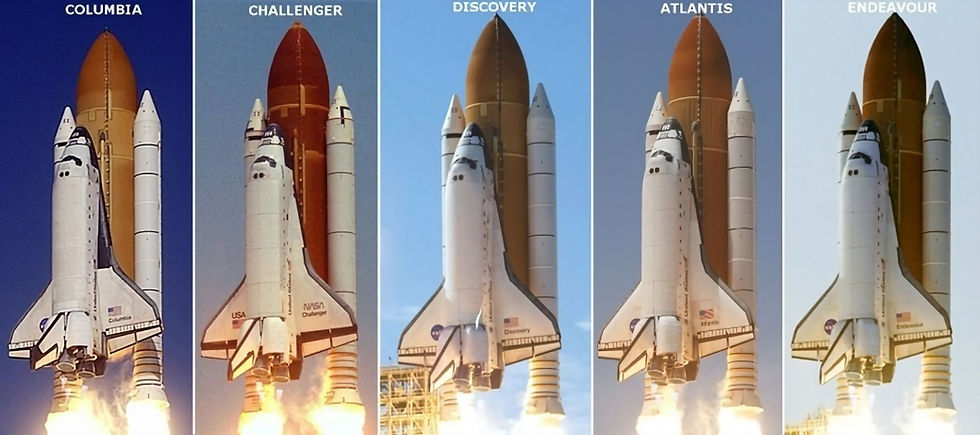How was the ISS constructed ?
- Hugo HENRY
- Apr 29, 2024
- 3 min read
The International Space Station (ISS) is a marvel of technology that has enabled a great number of research projects and experiments to be carried out in space, but above all it’s a symbol of peace, cooperation and development. Its construction and launch began in 1998, involving several international space agencies such as NASA (US), Roscosmos (Russia), ESA (Europe), JAXA (Japan), and CSA (Canada). The process took place in several distinct stages from the construction of the modules on earth to the assembly in space leading to the creation of this iconic orbital station.
1. Initial Modules

The ISS began with the launch of its first module, Zarya, which was sent into space on November 20, 1998, from Kazakhstan by a Proton rocket, a Russian heavy rocket capable of transporting 22 tons of payload. Zarya acted as a functional cargo block and a propulsion module. Shortly after, in December 1998, Unity, the second module, was sent by NASA's Space Shuttle Endeavour during the STS-88 mission. Unity and Zarya docked together with the help of the Space shuttle’s robotic arm after a rendezvous in space, forming the initial framework of the ISS.
2. Structure Expansion
Over the years, additional modules were added, thereby expanding the station's capabilities. Modules such as Zvezda for the living quarters and life support systems were launched by Roscosmos in July 2000. Subsequent shuttle missions added modules such as the Z1 truss, PMA-1 and PMA-2, as well as essential elements such as the Quest airlock for extravehicular activities. These modules were mainly built by the Americans and the Russians leading to a major contribution between the USA and Russia which was essential and paved the way of this extraordinary project. Today, the ISS is made up of 19 modules, including experimental, observation, logistics, supply and accommodation modules. The assembly of the ISS required meticulous coordination between astronauts on missions and operators on the ground. Each module was precisely positioned and connected to the station's other components using robotic arms and extravehicular activities.

3. International Contributions
Europeans, Japaneses and Canadians mostly contributed to new technologies and experiments. For example, they made the European Columbus and Japanese Kibō laboratories which were integrated into the ISS during shuttle missions between 2008 and 2009. This allowed to expand the station's research capabilities. These additions were succeeded in 2010 by the integration of the European Tranquility module, which provides vital life-support systems, and the Cupola observation module, which offers an impressive view of the Earth. The Canadians mostly contributed with their Canadarm, a robotic arm that was first use on Space Shuttle spacecrafts and later, in 2001, was implemented to the ISS. It helps the astronauts when maintaining and repairing the space station, as well as during extravehicular missions.

4. Launch Methods
Launches of modules and equipment to the ISS were primarily conducted using NASA's Space Shuttles like Atlantis, Endeavour, and Discovery which played a crucial role in assembling the ISS and made around 40 launches. These shuttles were tasked with specific missions to deliver modules, components, and crew members to the station because they can transport large payloads (16.4 tons) in their cargo bays and facilitated crewed missions for assembly and maintenance tasks with their Canadarm. Russia also used a lot of Proton rockets to launch their modules and components to the ISS especially the first ones. The Soyuz spacecraft also played an important role in cargo and crew transportation to and from the ISS and is still in use to this day. It carries supplies, equipment, and scientific payloads to support the ongoing station's operations.



Today, the International Space Station is fully operational and a great success. However, its very high annual cost (between 3 and 4 billion dollars) and its increasing age are pushing the partner countries to cease the program. At this time, Russia has announced that it will maintain its segment of the ISS until 2028, while the other countries want to keep it operational until at least 2030. At the end of its operational life, the ISS should be deorbited near the NEMO point, the furthest point on Earth from any inhabitant land, in the Pacific Ocean to avoid any damage to urban areas.
SOURCES :
- CANADA.CA, “Historique des vols du Canadarm” :
- ESA, “Building the International Space Station” :
- ISS National Laboratory, “The ISS Engineering Feat: Design” :
- NASA, “20 Years Ago, Construction Began on the International Space Station” :
URL : https://www.nasa.gov/image-article/20-years-ago-construction-began-international-space-station/
- Société Astronomique de France, “Le début de la construction de l’ISS avec les modules Zaya et Unity” :


















